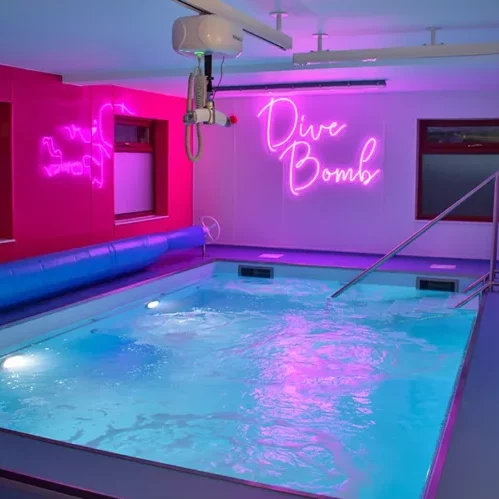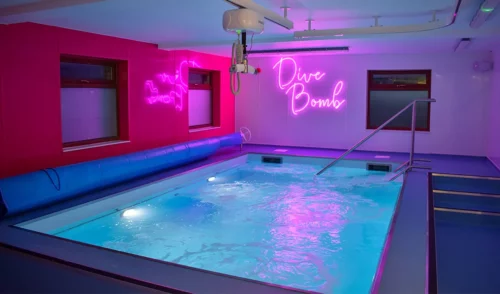Designing hydrotherapy pools for SEN schools
Posted on 3 October 2018 By Aaron Stretton

In This Article
New (and existing) special educational needs (SEN) schools are choosing more and more to include sensory hydrotherapy pools in their…
New (and existing) special educational needs (SEN) schools are choosing more and more to include sensory hydrotherapy pools in their buildings. This provides an opportunity for students to build physical strength and enjoy sensory stimulation with hydrotherapy pools for SEN schools.
But there are few different things to think of when you’re designing a hydrotherapy pool for a SEN school. Here’s what you should be considering with pools for schools.
What size should sensory hydrotherapy pools be?
The size of the pool is one of the first crucial decisions to make. It will determine how many people can use your pool at one time, and it will have a significant effect on the overall cost of your sensory pool.
Usually, you would only ever want two pupils and two carers in the pool at one time. This will give each child enough room and one-on-one time to make the most of the different features of the hydrotherapy pool.
Whilst there isn’t a formal swimming pool standard for sensory training, we’d recommend a 6 x 4 metre hydrotherapy pool. This gives enough space for each child and their carer to move around without feeling squashed or limited.
Another aspect of size to consider is the depth of the pool. For primary school-age children, the pool will need to be shallower to still allow them to stand comfortably without feeling out of their depth.
For any SEN school key stage 3 and above, we would suggest a deeper pool to cater to the range in height of the pupils.
Some hydrotherapy schools also choose to rent out their pool out of term time for swimming lessons and other activities. If your school is interested in hiring out its facilities, the pool will need to be bigger to allow for other activities.
The best hydrotherapy pools for infection control in SEN schools
Infection control is another facet to consider in SEN schools. Because the pool will be used by many children, the last thing you want is to facilitate the spread of bugs and illness.
A typical tiled hydrotherapy pool is actually not very good for infection control. The spaces between tiles and different grouted areas are a prime area for bacteria to latch on and grow.
This is one of the reasons why we only supply stainless steel hydrotherapy pools. Stainless steel is a particularly robust and hygienic material that does not scratch or promote bacterial growth on its surface.
Stainless steel is also good because it costs a lot less in maintenance and servicing over time. Find out more about the benefits of stainless steel hydrotherapy pools.
It’s also worth bearing in mind that our pools have a water filtration cycle of 45 minutes. That means that all the water will be filtered every 45 minutes on a constant cycle.
Hydrotherapy & sensory pool ideas
In terms of other options and features to include in the hydrotherapy pool, you might want to look at things that will be stimulating for the pupils using the pool.
We often find that SEN schools choose colour-changing lights for their hydrotherapy pools because they colour the entire tank of water. They also like to include air jets as standard.
We can also fit bubble mats in the base of the pool, and rain clouds above it for further sensory stimulation and fun.
Bear in mind other sensory and visual stuff. Big projectors with lights on the ceiling, blackout blinds etc., all help to enhance aquatic therapy for children with autism and other neurodivergent conditions.

Consider all of your senses to make a great sensory pool experience.
Evacuation procedures
In SEN schools, evacuation procedures are key — just like any other school. You need to make sure the pupils and staff can get out of the building quickly and efficiently, particularly when they are using the hydrotherapy pool.
As you can probably imagine, getting out of a SEN pool and out of a building takes a bit longer. Well, it takes even longer getting kids out of a hydrotherapy pool, particularly if they have physical disabilities.
One thing you can do that will make it easier to get students out of the pool in a hurry is to have the pool itself installed half-in the ground half-out. This makes the pool the perfect height for staff to get disabled pupils out of the pool and straight onto an evacuation trolley or couch.
Half-in half-out pools are also a good option in SEN schools because they deter children from running and jumping straight in the pool. It also makes it more difficult for them to fall in.
Hydrotherapy pool hoist access in SEN schools
One more thing to think about when designing a hydrotherapy pool for a SEN school is the overhead hoist access. The ceiling track hoist needs to have good coverage of the pool itself as well as a straight route to the changing rooms.
For SEN schools, we strongly recommend having a X-Y system over the pool itself, with two straight tracks connecting and leading into separate changing rooms. The changing rooms will be adjacent to the pool.
We also recommend having a X-Y system in each changing room to give full coverage in those areas as well. For more information on this, have a read of this article.
Summary
All in all, there are a few extra things to consider when designing a hydrotherapy pool for a SEN school. They might not be things you think about ordinarily, but they’re certainly important.
Make sure to look back on these five things every time you’re looking at designs like this to make sure you’ve thought of everything.
Speak to The Experts
Need assistance with product enquiries, general inquiries, or product support? Our Phonelines are open 9am - 5pm Monday to Friday
0113 519 0319
Or, fill out the form for a call back.
